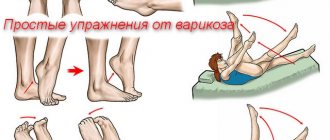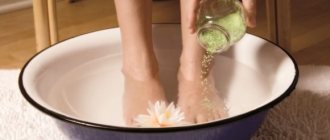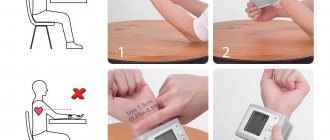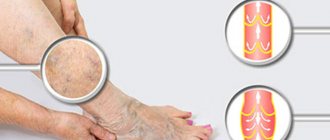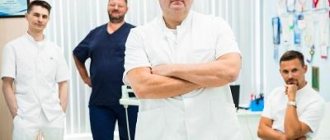From the point of view of modern European phlebology, five main stages of a disease such as varicose veins can be distinguished.
Stages of varicose veins or varicose veins of the lower extremities
According to the latest international data, tens of millions of Europeans suffer from various venous diseases, including manifestations of venous insufficiency. Only a small fraction of this enormous number seeks medical attention in a timely manner. On the territory of Russia, even in progressive Moscow and the Moscow region, a similar situation is observed. Without treatment, varicose veins inevitably progress and turn into a serious pathology with the development of dangerous complications.
Ultrasound diagnostics to identify the early stages of varicose veins
For good modern diagnostics in Moscow you need only 15-20 minutes. It is timely diagnosis that is necessary for good and correct treatment. Innovative technologies can also cope with the medical complications of varicose veins, but it is much better to prevent them.
Let's take a closer look at all 5 stages of varicose veins. It is better to take them seriously to avoid the development of serious complications. Today, millions of residents of our state, both urban and rural, are familiar with these stages of venous pathology first-hand.
Telangiectasia (spider veins) and reticular veins
The first stage of venous disease is reticular veins and telangiectasias. These veins are called arachnid veins in European medical literature. They are bluish-violet venous vessels that appear slightly above the surface of the skin. These veins got their name due to their web-like appearance. They are often quite small and difficult to see with the naked eye.
Stage I of varicose veins: intradermal varicose veins (telangiectasia)
People do not always pay attention to them and they go unnoticed for quite a long time, since at this stage there is no pain or discomfort. This doesn't mean you should ignore them completely. If you have spider veins, it is better to check the condition of the venous system for the presence of more serious pathology. A consultation with a good phlebologist will not take much time, but will help you avoid possible problems in the future.
Causes of spider veins include:
- Heredity
- Excessive static loads
- Pregnancy or menopause
- Hormonal imbalance
- Excess body weight.
At this stage, venous pathology is only a cosmetic, not a medical problem. In principle, the condition can be ignored, and most people do just that. But it's important to get a good diagnosis before your symptoms develop into something more serious. Many representatives of the fair sex, and not only in Moscow, are concerned about a cosmetic defect, which consists in the very presence of visible intradermal veins. Modern aesthetic procedures of sclerotherapy (scleroobliteration) can effectively help cope with the problem.
Treatment of stage I varicose veins using sclerotherapy
Varicose veins
Varicose veins, which stand out sharply above the surface of the skin, appear at this stage of the disease. From this moment on, the process acquires all the signs of not only a cosmetic, but also a medical problem. Varicose veins are enlarged, bulging and often tortuous. It is at this stage that most people begin to worry.
Stage II of varicose veins: varicose veins
And this is much better than perceiving the problem as purely cosmetic. The very presence of varicose veins already poses a threat of developing complications of varicose veins. In some patients, varicose veins are not accompanied by swelling of the legs or pain, while others experience aching pain along the venous vessels. Also, a number of patients experience a feeling of heaviness, nagging pain in the legs and feet.
Leading symptoms associated with varicose veins:
- Convex dark purple veins.
- Veins that appear twisted or tangled.
- Pain and heaviness in the legs.
- Burning or itching in the legs.
- Increased pain after standing for a long time.
- Bleeding from varicose veins.
- Inflammation and swelling of the legs around varicose veins.
If you experience thickening and pain in the area of a varicose vein, you should immediately contact a good professional phlebologist. These are manifestations of a complication such as thrombophlebitis.
Stage II varicose veins, complicated by thrombophlebitis on the thigh
The lack of timely medical care in this situation can end badly.
Possible causes of varicose veins include:
- Age - As we age, our veins lose their ability to expand and contract well, so they stretch without returning to their original shape. As a result, the valves in the veins weaken, then collapse, and the blood in these veins changes the direction of blood flow. Thus, blood flow in varicose veins takes on a pathological character.
- Pregnancy. When you are pregnant, the amount of blood in the body increases, the enlarged uterus puts pressure on the venous vessels. As a result, we get varicose veins in the legs.
- Rapid weight gain and hormonal imbalance also play a major role in varicose veins. An increased load on the venous system, coupled with a weakening of the venous wall, does not have the best effect on the condition of the veins.
- Increased static load is one of the leading causes of the development of varicose veins of the lower extremities.
What to do if veins appear on the legs?
The answer to this question is clear and simple: contact a phlebologist. Only a doctor who treats veins can conduct a detailed examination, correctly assess the patient’s condition and prescribe treatment, the main task of which is to remove the affected veins.
The most gentle treatment option for the patient is sclerotherapy - a non-surgical method that involves injecting a special sclerosant into the lumen of the vein, which leads to the closure of the vessel. The same result is achieved by the use of radiofrequency and laser therapy; in some cases, surgical intervention is necessary. The optimal method of treatment is always chosen by the doctor depending on the initial condition of the patient.
Phlebology Center specialists often answer patients’ questions related to the fact that veins protrude on the legs. We list the most frequently asked questions here:
Edema of the lower extremities
Along with varicose veins, swelling of the legs, ankles and feet often occurs. Edema leads to the development of chronic inflammation in the distal parts of the lower extremities.
Stage III of varicose veins: swelling in the distal parts
When you experience pain, discomfort and heaviness, these are often signs of an inflammatory response. The sensation can be relieved by elevating your legs above your heart, this helps circulate blood to your heart from your legs after long periods of sitting or standing. This problem will not be solved by itself; you need to contact a phlebologist in a good specialized medical center. The best solution would be to choose one of the best Moscow city phlebological centers, where leading specialists in this field work.
Here are the leading symptoms that should prompt you to seek medical help.
Symptoms accompanying inflammation in the legs with stage III varicose veins:
- Feeling of heaviness, fullness, swelling in the calves or ankles.
- Itching in the lower extremities.
- Numbness and pastiness in the distal parts of the lower extremities.
- Aching pain when walking and standing.
- Restless legs syndrome, when it becomes difficult to maintain a static body position.
- Muscle spasms, cramps in the calf muscles (usually at night).
Many of these symptoms are among the first serious signs of venous pathology, so if you have varicose veins and swelling, it is very important to get a diagnosis so as not to make the problem worse.
Venous trophic ulcer
A venous ulcer is classified as a chronic wound that occurs with a long history of varicose veins and has no tendency to heal. This occurs due to severe structural tissue damage due to impaired venous outflow.
Venous ulcers are caused by long-term chronic venous insufficiency.
V stage of varicose veins: trophic ulcer
Blood pools and stagnates in your legs because defective valves in the veins prevent adequate blood return to the heart.
Symptoms of leg ulcers:
- Painful open wounds on the legs or ankles.
- Itching sensations in the lower extremities.
- Discharge of yellow or green fluid from the ulcer.
- Swelling of the legs.
- Change in skin color around the ulcer.
- Pain in the area of the ulcer.
- Feeling of heaviness in the lower extremities.
Venous trophic ulcers account for up to 80% of all ulcers of the lower extremities. In the vast majority of cases, patients can be helped using modern technologies for treating varicose veins. Yes, most of them are treated. It is enough to contact a good phlebological center in Moscow and a competent specialist.
Many of the listed symptoms and complications of varicose veins are hereditary, so if you have family members with chronic vein disease and you experience any of these symptoms, you are definitely at risk. Factors such as obesity, diet, smoking and alcohol consumption can also have a detrimental effect on the health of your feet.
Varicose veins treatment. Conservative therapy
To the first group
conservative treatment applies. This type of therapy is used at all stages of varicose veins. It should be noted that in advanced stages of varicose veins, conservative therapy only complements the main treatment method: surgery, any endovenous innovative procedure or sclerotherapy (scleroobliteration).
Modern conservative treatment is aimed at strengthening the venous wall, eliminating venous stagnation and relieving the symptoms of chronic venous insufficiency (CVI). This group of treatment for varicose veins includes: phlebotonics (venotonic drugs), compression hosiery or compression bandages, variable pneumatic compression devices, electromyostimulators, manual lymphatic drainage massage procedures.
Phlebotonics and compression hosiery
Electromyostimulators and variable pneumatic compression devices
The main advantages of conservative methods are accessibility, the ability to carry out treatment at home, at a time convenient for the patient; you just need to consult a phlebologist. Conservative technologies have good therapeutic and preventive effects. Features of this treatment approach include:
- Conservative therapy, as a monotherapy, is effective only in the initial stages of the disease and for the prevention of varicose veins.
- In the presence of advanced forms of varicose veins of the lower extremities, such therapy is only complementary to more radical technologies.
Conservative treatment is successfully used by specialists from leading city phlebological centers and private clinics, as well as public hospitals in Moscow. Lastly, given the shortage of modern technologies, one can often note the disproportionate and unjustified use of conservative techniques. Perhaps the level of phlebological care in public health care could be significantly increased by improving interaction with good private medical centers. This applies not only to Moscow and the Moscow region, but also to any other region of our country.


